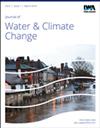Improving the forecasting accuracy of monthly runoff time series of the Brahmani River in India using a hybrid deep learning model
IF 3.1
4区 环境科学与生态学
Q2 WATER RESOURCES
引用次数: 0
Abstract
Accurate prediction of monthly runoff is critical for effective water resource management and flood forecasting in river basins. In this study, we developed a hybrid deep learning (DL) model, Fourier transform long short-term memory (FT-LSTM), to improve the prediction accuracy of monthly discharge time series in the Brahmani river basin at Jenapur station. We compare the performance of FT-LSTM with three popular DL models: LSTM, recurrent neutral network, and gated recurrent unit, considering different lag periods (1, 3, 6, and 12). The lag period, representing the interval between the observed data points and the predicted data points, is crucial for capturing the temporal relationships and identifying patterns within the hydrological data. The results of this study show that the FT-LSTM model consistently outperforms other models across all lag periods in terms of error metrics. Furthermore, the FT-LSTM model demonstrates higher Nash–Sutcliffe efficiency and R2 values, indicating a better fit between predicted and actual runoff values. This work contributes to the growing field of hybrid DL models for hydrological forecasting. The FT-LSTM model proves effective in improving the accuracy of monthly runoff forecasts and offers a promising solution for water resource management and river basin decision-making processes.利用混合深度学习模型提高印度布拉马尼河月径流时间序列的预报精度
月径流量的准确预测对于有效的水资源管理和流域洪水预报至关重要。在本研究中,我们开发了一种混合深度学习(DL)模型--傅立叶变换长短期记忆(FT-LSTM),以提高杰纳普尔站的布拉马尼河流域月径流量时间序列的预测精度。我们将 FT-LSTM 的性能与三种流行的 DL 模型进行了比较:考虑到不同的滞后期(1、3、6 和 12),我们比较了 FT-LSTM 与三种常用 DL 模型的性能:LSTM、递归中性网络和门控递归单元。滞后期代表观测数据点与预测数据点之间的间隔,对于捕捉水文数据中的时间关系和识别模式至关重要。研究结果表明,在误差指标方面,FT-LSTM 模型在所有滞后期的表现均优于其他模型。此外,FT-LSTM 模型显示出更高的纳什-苏特克利夫效率和 R2 值,表明预测值与实际径流值之间的拟合度更高。这项工作为水文预报中不断发展的混合 DL 模型领域做出了贡献。事实证明,FT-LSTM 模型能有效提高月度径流预报的准确性,为水资源管理和流域决策过程提供了一个前景广阔的解决方案。
本文章由计算机程序翻译,如有差异,请以英文原文为准。
求助全文
约1分钟内获得全文
求助全文
来源期刊

Journal of Water and Climate Change
WATER RESOURCES-
CiteScore
4.80
自引率
10.70%
发文量
168
审稿时长
>12 weeks
期刊介绍:
Journal of Water and Climate Change publishes refereed research and practitioner papers on all aspects of water science, technology, management and innovation in response to climate change, with emphasis on reduction of energy usage.
 求助内容:
求助内容: 应助结果提醒方式:
应助结果提醒方式:


